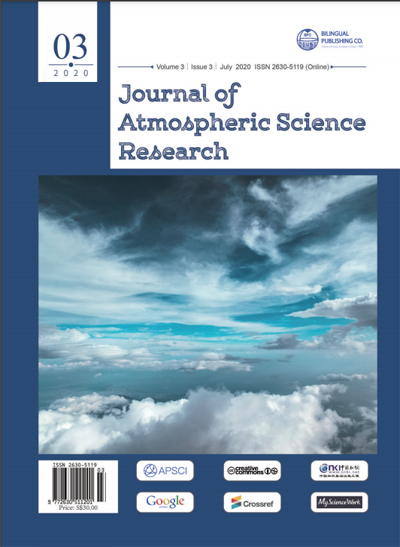-
2081
-
1502
-
1495
-
1366
-
1230
Development and Rapid Intensification of Tropical Cyclone OCKHI (2017) over the North Indian Ocean
DOI:
https://doi.org/10.30564/jasr.v3i3.2177Abstract
Tropical Cyclone OCKHI over the North Indian Ocean during 2017 underwent dramatic development and rapid intensification very close to the land - Sri Lanka, extreme South Indian coast and Lakshadweep area during its initial developmental stage and caused extensive damages over these areas. On examining the physical and structural mechanism involved in such development, it is observed that the initial development was associated with axi-symmetrisation of the vortex that could be associated with Vortex Rossby waves near the eyewall. Associated with the expulsion of high vorticity from the centre during asymmetry mixing, there was outward propagation of eddy angular momentum flux in the lower levels that strengthened a low level anticyclone to the northeast of the TC centre which in turn enhanced the cyclonic inflow near the TC centre. The rapid intensification phase was associated with vertical non-uniform heating with upper and lower tropospheric warming associated with latent heat release in convection. During the mature phase, the system sustained ‘very severe’ intensity even under increasing vertical shear and lower ocean heat flux under the influence of a break in the sub tropical ridge to the north of the system centre that enhanced the poleward outflow in the upper troposphere.Keywords:
Tropical cyclone, Ockhi, Asymmetry, Eddy flux convergence, Heat and moisture budgetReferences
[1] Riehl, H. Tropical Meteorology[M]. McGraw-Hill,1954.
[2] Merrill, R.T. Environmental-influences on hurricane intensification[J]. J. Atmos. Sci, 1988, 45: 1678-1687.
[3] DeMaria, M., Baik, J.J., Kaplan, J. Upper-Level Eddy Angular Momentum Fluxes and Tropical Cyclone Intensity Change[J]. J. Atmos. Sci., 1993,50(8): 1133-1147.
[4] Rhome, J.R., Sethuraman. Environmental influences on tropical cyclone structure and intensity: a review of past and present literature[J]. In. J. Mar. Sci.,2006, 35(2): 61-74.
[5] Hendricks, E.A., Peng, M.S., Fu, B., Li, T. Quantifying Environmental Control on Tropical Cyclone Intensity Change[J].Mon. Wea. Rev., 2010, 138: 3243-3271.
[6] Stevenson, S. N., Corbosiero, K.L., Molinari, J. The convective evolution and rapid intensification of Hurricane Earl (2010)[J]. Mon. Wea. Rev., 2014,142: 4364-4380, DOI: https://doi.org/10.1175/MWR-D-14-00078.1
[7] Bosart, L. F., Velden, C.S, Bracken, W.E., Molinari, J.,Black, P.G. Environmental influences on the rapid intensification of Hurricane Opal (1995) over the Gulf of Mexico[J]. Mon. Wea. Rev., 2000, 128: 322-352.
[8] Knaff, J.A., Kossin, J.P., DeMaria, M. Annular hurricanes[J].Wea. Forecasting, 2003, 18: 204-223.
[9] Montgomery, M.T., Enagonio, J. Tropical cyclogenesis via convectively forced vortex rossby waves in a three-dimensional quasi-geostrophic model[J]. J. Atmos. Sci, 1998, 55: 3176-3207.
[10] Corbosiero, K.L., Molinari, J.; Aiyyer, A.R., Black,M.L. The structure and evolution of hurricane Elena (1985) Part II: Convective asymmetries and evidence of Vortex Rossby Waves[J]. Mon. Wea. Rev. 2006, 3073-3091.
[11] Yu, Yubin., Xiuping, Yao. Thermodynamic Characteristics of Tropical Cyclones with Rapid Intensity Change over the Coastal Waters of China[J]. Acta Meteorologica Sinica, 2010, 25(4): 467-477.
[12] Balachandran, S., Geetha, B. Diagnostics of Upper Level Dynamics and Rainfall Asymmetry of Very Severe Cyclonic Storm MADI (2013)[M]. In Tropical Cyclone Activity over the North Indian Ocean (Eds. Mohapatra et al), Capital Pub Co., New Delhi, 2016.
[13] Molinari, J., Vollaro, D. External Influences on Hurricane Intensity, Part I: Outflow Layer Eddy Angular Momentum Fluxes[J]. J. Atmos. Sci., 1989, 46(8):1093-1105.
[14] Geetha, B., Balachandran, S. Diabatic heating and convective asymmetries during rapid intensity changes of tropical cyclones over North Indian Ocean[J]. Tropical Cyclone Research & Review, 2016, 5(1-2):32-46.
[15] Wang, H., Wang, Y. A numerical study of Typhoon Megi (2010). Part-I: Rapid Intensification[J]. Mon. Wea. Rev., 2014, 142: 29-48.
[16] Yanai, M., Esbensen, S., Chu, J.H. Determination of bulk properties of tropical cloud clusters from large scale heat and moisture budgets[J]. J.Atmos. Sci.,1973, 30: 611-627.
[17] Chen, S.S., Knaff, J.A., Marks Jr, F.D. Effects of vertical wind shear and storm motion on tropical cyclone rainfall asymmetries deduced form TRMM[J]. Mon. Wea. Rev., 2006, 134: 3190-3208.
[18] Lonfat, M. Marks J,. F.D., Chen, S.S. Precipitation Distribution in Tropical Cyclones Using the Tropical Rainfall Measuring Mission (TRMM) microwave imager: A global perspective[J]. Mon. Wea. Rev.,2004, 132: 1645-1660.
[19] Kotal, S.D., Bhowmik, S.K.R. Large scale Characteristics of rapidly intensifying Tropical Cyclones over the Bay of Bengal and rapid intensification Index[J]. Mausam, 2013, 64(1): 13-24.
[20] Montgomery, M.T., Kallenbach, R.J. A theory for vortex Rossby-waves and its application to spiral bands and intensity changes in hurricanes[J]. Quart. J. Roy. Meteor. Soc., 1997, 123: 435-465.
[21] Kieper, M., Jiang, H. Predicting tropical cyclone rapid intensification using the 37 GHz ring pattern identified from passive microwave measurements[J]. Geophys. Res. Lett., 2012, 39: L13804. DOI: https://doi.org/10.1029/2012GL052115
[22] Reasor, P.D., Montgomery, M.T., Marks Jr, F.D., Gamache, J.F. Low wavenumber structure and evolution of the hurricane inner core observed by airborne dual-Doppler radar [J]. Mon. Wea. Rev., 2000, 128:1653-1680.
[23] Chen, X., Zhang, J. A., Marks, F.D. A thermodynamic pathway leading to rapid intensification of tropical cyclones in shear[J]. Geophys. Res. Lett, 2019, 46:9241-9251.
[24] Rucker, J.H. Upper-Tropospheric Forcing on the Intensification Rates of Tropical Cyclones Flo and Ed based on TCM-90 observations[D]. Masters’ Thesis-Naval Postgraduate School, Monterey, California, 1992.
Downloads
How to Cite
Issue
Article Type
License
Copyright © 2020 Author(s)

This is an open access article under the Creative Commons Attribution-NonCommercial 4.0 International (CC BY-NC 4.0) License.




 Geetha B
Geetha B





